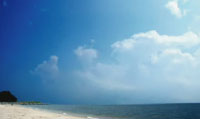 |
NASA | GSFC | JPL | Site Map |
|
|
 |
 |
Education: Student Outcomes |
Click here to search for other assets Water, Water Everywhere: Condensation & Precipitation Grade levels: K-4, 9-12 Themes: ocean circulation, water cycle Video: water_everywhere_02.flv
Condensation is the process by which water vapor molecules cool, stick together, and become liquid again in cloud formation. This often happens high in the atmosphere where the temperature is much lower than it is near the surface. Paula Bontempi: "What happens in the atmosphere is, just like we have currents in the ocean, we have winds in the atmosphere that actually, to some extent, drive what goes on in the ocean currents. Materials in the atmosphere can travel a great distance, sometimes a quarter of a way around the world, just until they get to the point where they actually turn into rain or snow and thereby fall back to the ocean or fall back to the land. This is called precipitation. If the water molecule falls on the land as snow, it may be stored for a very long period of time in a polar ice sheet or mountain glacier, depending on climate conditions." Matt Rodell: "When rain falls or the snow melts, typically the next place it goes, it infiltrates the soil. So soil is not solid. It's not like a rock, there are pore spaces that can be filled with water and typically there is a certain amount of water in the soil at all times. If soil was completely dry, plants wouldn't be able to grow." (source) Student Outcomes After viewing this video, students should be able to: Describe the connections between the salt water found in the ocean and the fresh water in the water cycle. (O: K-4) Explain the relationship between fresh water and ocean dynamics. (W: 9-12) Key: C = climate / O = ocean circulation / T = 21st century technology / W = water cycle |
|||||
